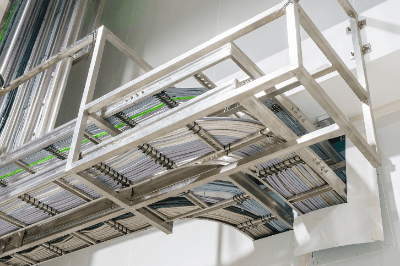What Is Cable Rack?
 A Cable Rack is a rack for laying cables on.
A Cable Rack is a rack for laying cables on.
It is used to lay a large number of cables over long distances in an orderly and efficient manner. In most cases, cable racks are sold in units of 3 meters per cable, which are connected together to create long distances. It is not unusual to lay several hundred meters of cable, and they are used in relatively large facilities such as public facilities, factories, and laboratories.
Cable racks are generally installed by combining multiple cable racks or installing separators to separate the different types of wiring.
Uses of Cable Racks
Cable Racks are used for laying cables in large facilities. The following are examples of locations where cable racks are used:
- Processing plants and large-scale plants
- Event halls and office buildings
- Large commercial facilities
Cable racks are used in many locations in facilities above a certain size. Cable racks can be used to ensure safety within the facility by laying the wires in locations where passersby cannot easily touch them. Multiple wires can be laid at the same time, improving workability.
Compared to conduit, a larger number of wires can be laid. Therefore, short distances or a small number of cables can be laid with conduit, while cable racks are selected for long distances with a large number of cables.
Principle of Cable Rack
Cable racks are often made of metal materials, such as galvanized steel sheet or aluminum. Stainless steel or reinforced plastic may be used for corrosion resistance, for example, along the coast. They are generally sold in a rectangular shape with a longitudinal length of 3 meters.
When laying the cable rack, it is fixed with bolts attached to the ceiling to hang the cable rack, and accessories such as end caps are attached. Support at intervals of 2 m or less for steel products and 1.5 m or less for other materials. Where the cable connects with straight lines and other shapes, it should be supported near those areas and near the end of the cable rack.
Cables should be supported at intervals of 3 m or less in horizontal locations and 1.5 m or less in vertical locations. Exceptions are made if the cable rack is a tray type or if the cable is to be routed inside a double ceiling. When routing cables vertically, the weight should not be concentrated only on one child girder.
In consideration of earthquakes, cable racks should be secured at regular intervals during installation to prevent shaking. Since the metal cable rack itself may expand and contract when there is a large difference in temperature between cold and hot, expansion joints may be installed at intervals of 30 m or less to avoid this.
Types of Cable Racks
Cable Racks can be roughly classified into two types: ladder type and tray type.
1. Ladder Type
Cable Racks are ladder-shaped and often have a girder every 0.3m. Cables are secured to the girders with hemp cord, insulock, or other means. Cable Racks are widely used because cables can be visually observed.
Because of its light weight and low cost, this cable rack is frequently used in factories. When laid in places where passersby can see them, such as commercial facilities, they may degrade the design. Therefore, they are often installed in attics or inside walls in commercial facilities and event venues.
Cable Racks are also available in wider widths compared to tray-type cable racks; some are over 1 m wide, making them ideal for huge plants, for example. A wider range of materials is also available compared to the tray type.
2. Tray Type
This type of cable rack has a tray-like bottom that is closed with a steel plate or the like. To secure cables, strings or bands are passed through holes at regular intervals on the bottom. The feature of this type of cable rack is that the cables themselves can be held stable by the bottom surface.
The cables can also be concealed, thus ensuring good design. Because of this feature, they are widely used in public facilities, commercial facilities, and offices. However, because of its bottom surface, it is more expensive than the ladder type.